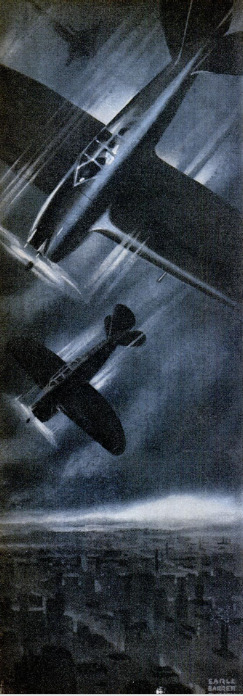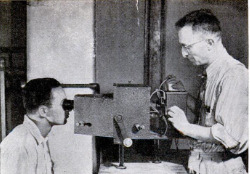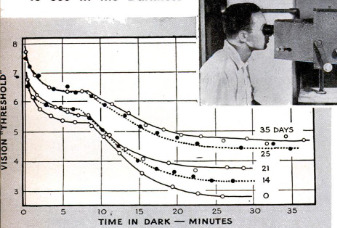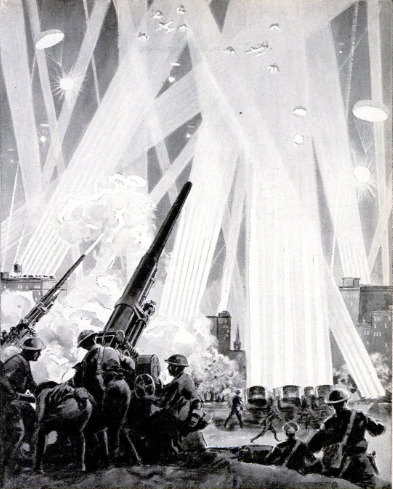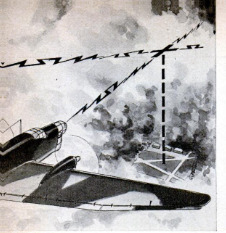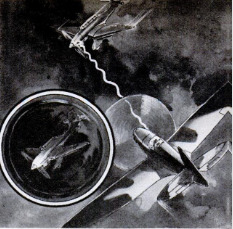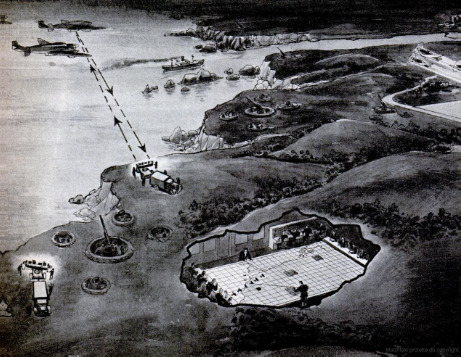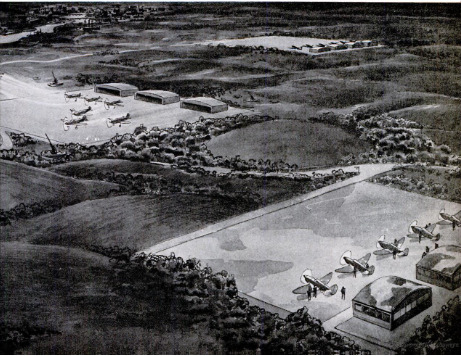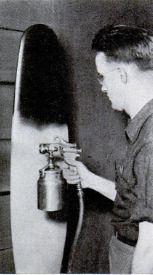-
Title (Dublin Core)
-
How warplanes fight at night
-
Article Title and/or Image Caption (Dublin Core)
-
Title: How warplanes fight at night
-
extracted text (Extract Text)
-
SOMEONE years ago said, “War is
for the general, an art; for the
officer, a science; for the soldier,
a trade.”
No war agency demonstrates this
more clearly than that greatest of
modern weapons, air power. The fist
of the air arm is the bomber, and the
long-reaching arm defies fortifications,
unfavorable terrain, and great ex-
panses of sea when the time comes for
the deadly punch to be delivered. In
order to thwart aerial and ground op-
position once these far-removed objec-
tives are attained, the bombers fly by
night more frequently than during the
daylight hours, particularly when their
missions involve the bombardment of
stationary, well-defended sites such as
cities, industrial areas, and wharfage.
Indeed, where the balance of air su-
periority is closely contested, where the
air arms boast parity of quality, quan-
tity, and flying personnel, day bombing
of such objectives has proved too cost-
ly; except, perhaps, for sporadic, hit-
and-run raids by fast fighter-bombers
and dive bombers. Precision bombing
of targets is abandoned in favor of
widespread incendiary and demolition
bombing on an indiscriminate scale cal-
culated to destroy the morale of ci-
vilians in a “war of nerves.”
Some rather interesting tactics are
employed by the night bombers. Moon-
light visitations are frequent because
the clear definition of targets in the
reflected light enables the bombardiers
to use their bombing sights effectively,
even from the high altitudes at which
the defenders’ antiaircraft forces them
to fly. Furthermore, bright moonlight
greatly nullifies the probing search-
light beams. On the darker nights, a
favored practice is for the raiders to
attempt lighting up the landscape with
high-powered parachute flares. While
this works in some instances, in just as
many cases it is not successful. The
flares tend to burst too high up and burn
out before they drop low enough to reveal
the objective; when they burst close enough
to be effective the defenders can usually
shoot them out.
Where the antiaircraft fire is particularly
hot, incendiaries are used as markers. The
fighter-bombers dive low enough to dis-
tinguish the target, relying upon their speed
and maneuverability to foil the AA guns
and searchlights, and drop thermite-oil
bombs. The heavy and medium bombers
higher up are then able to unload their eggs
on the blazing targets. This, too, works ex-
ceedingly well for a while—until the fire
brigades and civilians are organized to
pounce upon and extinguish the incen-
diaries as they fall. When this happens, the
attackers resort to a combination of de-
molition and fire bombs, hoping thereby to
kill or frighten off the vigilantes on the
rooftops or in the streets.
Pattern bombing from high-flying forma-
tions under radio control is another inter-
esting and deadly technique. High-fre-
quency beams, much like those which guide
our airliners through the night along the
invisible airways, are projected by the at-
tackers over the city or area to be bombed,
and these are crossed over—directly above
the chosen objective—by other beams di-
rected on an angular bearing from points
far removed from the transmitters of the
guiding beams. The attacking pilots follow
the latter beams from the time of take-off
until they intersect the second, or marker
beam, at which time they know themselves
to be over the spot. The bombs are then
released “in salvo,” dumped en masse, from
altitudes well above the reach of the de-
fender's AA and searchlights.
Even this ingenious scheme can be
thwarted, and the bombees exploit every
countermeasure. With equally ingenious
gadgets, they proceed to “scramble” the
beams so that the enemy airmen receive a
lot of static and no further guidance. The
beams may also be “bent” in such a man-
ner that the bombers are led through an
open switch, as it were, and off course to
some point over open country or water
where the missiles can do little or no harm.
To accomplish this, the defenders resort to
the simple expedient of emitting a beam of
their own, on the same frequency as the
enemy's, to intersect his somewhere along
the line. It may be readily understood, how-
ever, why the riddle of the night bomber |
is far too complex a problem to be perma-
nently solved so easily. Because one of the
principles of warfare—ground or aerial— |
is that the element of surprise must be
continually sought by the offensive striking |
force, the night bomber is still the military |
“big stick.”
But another axiom of war is that a new
weapon is five times as hard to conceive
and bring into successful operation as is the |
counterweapon to neutralize it. Through
the combination of several interesting de- |
vices, the United States is well along with
the solution of the problem of the night |
bomber at this writing. These defenses may
be classified as direct and indirect. The
only direct defense against the bombing
plane is the interceptor plane, and it is |
most certainly the most successful neu-
tralizer. The indirect defenses may be |
considered as passive and active. Devices
such as camouflage, blackouts, and even the |
balloon barrage go into the former cate-
gory. For lack of space, let us consider the
active measures.
The increasing effectiveness of antiair- |
craft is the result of the development of
clever fire-control gadgets and of the
stepped-up firing rate and longer reach pro-
vided by today's gun designers. These AA
guns are of three general types: The rapid-
firing cannon which throws shrapnel shells
in the paths of high-flying bombers, the
pom-poms or automatic shell cannon used
to supplement the longer-range guns against
raiders flying lower than 6,000 feet, and the
machine gun for inside defense against
low-flying craft in general and attack planes
and dive bombers in particular.
Defenders manning the automatic guns |
can, with fair success, draw a bead on the
enemy craft or throw up a curtain bar-
rage in front of the raiders. But because
too many corrections must be made for the
high-flying bomber's speed, altitude, dis-
tance, and other factors, the men behind
the heavy guns have to depend upon fire-
control instruments. These include the
mechanical “ear” or detector, used to de-
termine the direction of approach; the
range-finder, through which the enemy
plane is spotted and its altitude (in verti-
cal yards) ascertained; and the predictor,
which assimilates prior information and |
computes automatically and continuously
the data (such as the plane's speed,
distance, drift, and recommended ballistic
corrections) the gunners and cannoneers
require before going into action and during
the action. After sunset, the defenders are
confronted by two enemies—their adver-
saries and the darkness. Searchlights are,
of course, necessary to spot the raiders and
permit the range-finder and predictor op-
erators to carry on. A codrdinating gadget
known as a “comparator” is connected with
both the “ear” and the lights. Supplied the
approximate bearing of the approaching
ships, the comparator aims the lights and
moves them in systematically widening
circles until the enemy is sighted.
The searchlight has its limitations, how-
ever. Ours are admittedly the finest in the
world, emanate some 800,006,000 candle-
power, but even these suns on wheels are
not effective against craft flying higher
than 12,000 feet. Anything between a half
and full moon cuts down the beam pro-
portionately. What the gun crew can't
see they can't hit, unless their luck is run-
ning pretty high. And it takes more than
luck to stop a bomber speeding through the
blackness of three dimensions. The night
fighter, aided by two remarkable electrical
devices and the indirect defenses mentioned,
is the ace that is neatly turning the trick.
Constant air patrol of one's coastlines is
impractical because of the prohibitive num-
ber of aircraft and personnel required and
the great expenditure of valuable fuel.
Interception of enemy craft in the darkness
is much too dependent upon chance, as is
also the pilot's ability to keep hostile planes
within view if and when they are engaged
in combat. How is it accomplished?
The first essential is an efficient ground
control and dispatching organization. The
Army Air Corps and Signal Corps have
developed a clever method involving the use
of a new electric plotting board. These
goings-on are, for obvious reasons, very
much under wraps, but the British have
developed a somewhat similar plan which
it might be well to study.
The nerve center of their operations
scheme is the Fighter Command Headquar-
ters whose job it is to codrdinate enemy
information and dispatch the night fighters
accordingly. The Isles are divided into
“sectors,” in each of which are one or more
airdromes accommodating a fighter squad-
ron. Each sector is furnished its own head-
quarters and operations room—a large
room taken up almost completely by a scale
table map representing sections of the Isles
and the surrounding sea area and enemy
coasts on which an officer known as the
“controller” plots the air action. Several
junior commands called “groups” comprise
a number of these sectors.
The scheme works this way: The radio
locators—of which more will be said short-
ly—of a couple of the coastal stations of
the Observer Corps detect a number of
approaching bombers. Word is flashed to
the Fighter Command. The controller here
immediately advises group operations to
order all the squadrons in the sectors within
that particular group to “stand by,” which
means that the pilots are seated in their
warmed-up fighters, ready to take off on
signal. The fighters in the sector nearest,
or on the line of the approaching raiders,
are ordered up. Meanwhile, the squadrons
in adjacent sectors stand by, and others
under the group control are held “in readi-
ness,” with the pilots fully dressed and
close by their ships. More of the squadrons
farther inland are held “available,” ready to
take off within a few minutes of the order.
To keep from being caught off base, in
the event of ensuing waves of bombers or
a number of simultaneous raids at scat-
tered points and so that the fighters aloft
may be relieved before they run out of fuel
and ammunition, operations are staggered. |
When the first squadrons are sent up, those
in readiness are moved up to stand by; |
those held available are placed in a state
of readiness; and others which have been
released from duty are called up so as to
be available. Controllers in the three re-
spective operations rooms list the fighter
units on blackboards according to the degree
of their “alert.” In this manner, each con-
troller is able to tell at a glance just who
is doing what.
From the moment the raiders are first
reported, their course is traced on the huge
table maps and progress is noted by mov-
ing markers along the course. Antiaircraft
units and the balloon-barrage units are
meanwhile advised of the enemy's where-
abouts. As soon as the fighter unit which
has been ordered aloft has gained altitude,
the controller radios the squadron leader
to pursue a “vector,” or heading, by Which
his fighters will intercept the raiders. The
controller often advises the leader what
cruising speed and altitude to maintain.
When the fighter-squadron marker and the
enemy marker meet each other, the con-
troller notifies the leader of the bombers’
proximity. As soon as the bombers are sight-
ed, the leader gives the “enemy sighted”
signal. Success, obviously, depends upon
the accuracy of the controller's information.
‘The radio locator is so accurate that it not
only determines the bombers’ course but
also their speed and altitude.
Operating on the well-known principle
that radio waves, upon striking some ob-
stacle, are reflected in much the same man-
ner as echoing sound waves, the interesting
gadget utilizes extremely short waves
called “microwaves.” Ultra-short waves
provide a sharper echo. American airliners
have, for some time, been using a terrain-
clearance indicator Which operates on the
same principle. The locator might be de-
scribed as one of these absolute altimeters
in reverse; instead of the waves being
projected down to the ground and bouncing
up to the plane, the locator’s beam is fo-
cussed upward, hits the enemy plane, and
bounces back to the ground. The time in-
terval between emission of the beam and
the return of its echo is measured electri-
cally and translated into feet of altitude.
Radio waves, unlike the sound waves on
which the antiaircraft “ears” depend,
travel at constant speed—the same speed
as light waves, 186,000 miles per second.
Even more remarkable is another elec-
trical contrivance which enables the pilots
to spot the planes in the darkness. It is
called the “A-eye” and utilizes infrared
rays. Installation details may not be re-
vealed at this time, but the general prin-
ciple—which is well known to scientists the
world over, and has been since 1934—is
somewhat similar to that of television.
There are two phases to its development.
Two highly sensitized screens are mounted
on the night fighter in
such position that they
may be used in con-
junction with the re- |
flector gunsight. The
front screen, a thin
metal plate coated |
with a layer of caesi- |
ated oxidized silver, is |
sensitive to infrared ra-
diation to about 11,000
angstrom units—3,000
units above the visual
limit. When the image, |
resulting from infrared
radiation of the enemy
plane's motor, is |
caught on this screen,
it emits a stream of |
electrons therefrom.
This electron image, in |
turn, shows upon a |
second screen—a plate |
coated with a fluores.
cent compound, em-
ploying the same prin-
ciple as the X-ray
fluoroscope—and is |
turned into a distinct
image of high illumi-
nation. This, however,
results in the showing |
of too tiny a target for |
high-speed combat
planes, and there was also the probability
of a pilot shooting at a friendly ship.
This condition led to the second phase of
development. The “A-eye,” fortunately, is
sensitive to objects reflecting infrared rays
as well as those radiating the rays, and
an infrared searchlight was developed
which was compact enough to be car-
ried in a plane. When used in conjunc-
tion with the eye and sight, it permits the
pilot to “lay” the whole plane, or more than
one plane and be certain of its identity.
This is all that is required, since the size
of the enemy plane—indicated by the
amount of space the image occupies in the
reflector disk—reveals its distance away
from the pilot. In addition to this device,
we have a secret antiaircraft detector which
works on the same principle.
One of the most interesting aspects of
night defense is that involving the human
element. The conditioning of airmen for
night fighting has much to do with success-
ful operations. The first task of the medi-
cos is to carefully select pilots and gun-
ners who are not subject to “night blind-
ness.” More than a few of the crack fliers,
particularly those older than 25 years,
whose vision proves adequate for daytime
operations are found to have poor “dark
adaptation.” This is
the process by which
the eyes accustom
themselves to darkness;
a common phenom-
enon you experience
when entering a_thea-
ter from the bright
daylight. If there hap-
pens to be little light
on the screen at the
time, it is somewhat
difficult to find your
seat. By the time you
are ready to leave,
however, there has tak-
en place a change and
you can see perfectly
well. What happens is
that the vision thresh-
olds diminish gradually
for about half an hour,
after which time one's
ability to see in the
dark is at the maxi-
mum.
Conditioning of air-
men is commenced im-
mediately following the
selection of those Who
are found to have ade-
quate dark adaptation.
They maintain a
diet which is particularly high in vitamin
A and carotene content, then the men are
given periodic injections of vitamins A and
1. The next phase involves having the flyers
and gunners spend periods of time in dark-
ened rooms. During the time that they are
on duty, waiting in their quarters to go
aloft, the men wear dark-green goggles
similar to those worn by welders, except
that they have a tight-fitting rubber mask
to_cut oft light from the sides or bottom.
When the signal for the take-off comes
through from operations, their eyes are
predisposed to the darkness outside. With-
in a moment or two, the airmen's vision
thresholds are fully lowered, their night
sight at its best. Deprived of this adjust-
ment, they would dash out of a brightly
lighted room onto the necessarily blacked-
out field and would be able to see little if
anything, unless the moon happened to be
very bright. Even if they were able to take
oft safely, their night vision would not be at
its best for approximately 30 minutes. This
time element is vital, considering that the
pilots can take off and climb to 10,000 feet
in about ten minutes and, in all probability,
‘make contact with the enemy within anoth-
er five or ten minutes. The retina, which is
equivalent to the film in a camera, does
most of the adjusting, and this part of the
eye is dotted with tiny receplors called
“rods” and “cones.” A quantity of pigment
known as “visual purple” is present in the
rods, and this may be compared to the emul-
sion on the camera film.
The first stage of adaptation requires
about ten minutes, during which time cone
threshold is lowering and you lose color
perception. Then the rods take over, and
during this second stage it takes them 20
minutes longer, just three times as long as
the cones, to complete their function. Now
objects appear a vague misty gray in color
and indeterminate in size and shape; night
vision is in effect.
Reproduction of tie visual-purple sub-
stance on the retina has been found to be in
direct proportion to the amount of Vitamin
A in the system. This substance is essential
to successful dark adaptation. Diet thus
becomes of increasing importance in the
conditioning of flying personnel.
Dr. Selig Hecht of Columbia University,
Dr. H. De Silva of Yale, Col. A. D. Tuttle of
United Airlines, and Dr. W. R. Miles of the
National Research Council are working in
close codperation with the aviation medi-
cine departments of our Air Corps and Na-
val Air Service on night-vision research.
Last, but far from least in this battle
against the night bomber, is the problem of
employing suitable types of aircraft for
these “cat-eyed” men to fly. Generally
speaking, the same characteristics are de-
sirable in night craft that make for efficient
daytime fighters and interceptors: speed,
maneuverability, fast rate of climb, high
ceiling, heavy fire power, ease of mainte-
nance, and safe landing and take-off char-
acteristics. Nighttime combat, however, is
mostly a hit-and-run affair, and there is
not so much close-in fighting and violent
maneuvering as in daylight scraps. The
main requisites are armament to shoot
quickly, and in quantity, at the suddenly
looming enemy, and good landing behavior.
Tactical use of these craft involves send-
ing the long-range convoy-type fighters over
enemy territory to carry out “watch-and-
wait” strategy while holding the fast-
climbing interceptor types for immediate
engagements. The fighters hover over
cnemy air bases at high altitudes, then
swoop down to nail the enemy bombers as
they come home to roost. This is excellent
strategy in that the bomber crews are
pretty well unnerved, as well as being just
about out of fuel and ammunition, after
braving the interceptors and AA fire. It is
natural for them to breathe a sigh of relief
as their airdromes slide into view, and the
psychological let-down comes when the long-
range fighters appear out of nowhere.
Our newly formed Air Lorps Interceptor
Command is to be supplied with several
modified types of planes for night opera-
tions. Long-range types could conceivably
be the 458 m.p.h. Lockheed P-3SE and the
420 m.p.h. Grumman P-50A. A sterling ar-
ray of smaller pursuit-interceptors includes
the Bell P-39C “Airacobra,” Curtiss P-42
and P-46, Republic P-43 “Lancer,” P-4TB
“Thunderbolt,” and the North American
P-51 “Apache.” These ships are the finest
of their types in the world, and we may
rest assured that the American air chief-
tains know, perhaps better than any of
their contemporaries on this troubled globe,
the answer to the riddle of the night bomb-
er.—JAMES L. H. PECK.
-
Language (Dublin Core)
-
Eng
-
Date Issued (Dublin Core)
-
1941-10
-
pages (Bibliographic Ontology)
-
83-88,220,222
-
Rights (Dublin Core)
-
Public domain
-
Archived by (Dublin Core)
-
Sami Akbiyik
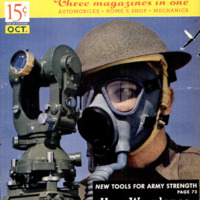 Popular Science Monthly, v. 139, n. 4, 1941
Popular Science Monthly, v. 139, n. 4, 1941

